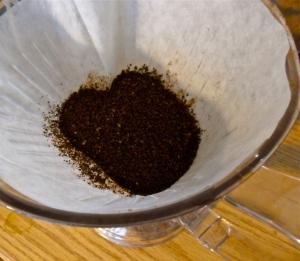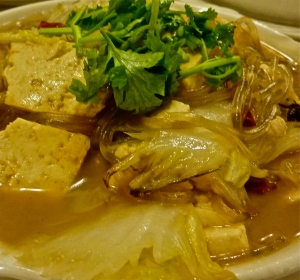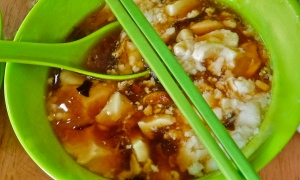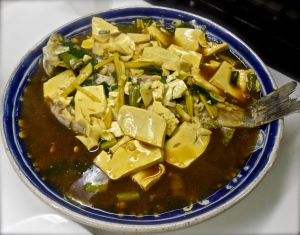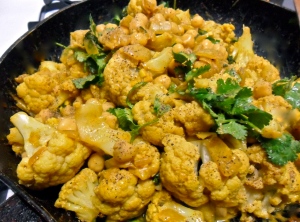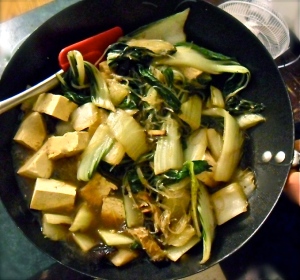I’m Sorry
You may or may have noticed the lack of posting lately. Don’t worry– the Octopus still lives, but sometimes you need to take a break and acknowledge that:
1. Ultimately, we eat to live, not live to eat
2. I have such a one-track mind when it comes to food and coffee that I need to take some time to embrace other interests.
But I’ll definitely be back within the next few weeks– to be honest, our kitchen is being renovated and you haven’t missed anything anyway.
See you soon and hope you keep reading,
Octopus Gourmet
Flat Scallion Omelet
Think of this as a sort of scallion pancake– Pajeon hybrid: all egg, no flour. A frittata, Asian style. Really, who knows what it is? In an effort to add some kind of main protein to last night’s meal, I turned on the stove, beat some eggs, and it was all a gamble from there.
Well, it really isn’t a gamble, provided you have some experience with eggs. Scrambled eggs, omelets and frittatas are among the first things I learned to cook. You have to wait until your oil/ butter is sizzling before pouring in the eggs, letting the edges set over medium-high heat until slightly crispy. You have the option of adding your fillings before or after cooking; the same goes for whether your omelet will be folded or flat.
I envisioned a rice-less version of FOOG’s fried rice, which includes scallions, shredded carrrots, egg, and oyster sauce (recipe to come, I promise). Unfortunately, since we were cooking in a Kosher kitchen, the oyster sauce was out– still, gobs of chili paste managed to make up for that.
This really is more of a general concept than an actual dish– feel free to add leftover shrimp, tofu, any combination of vegetables (although some may need to be cooked first), and serve with any dipping sauce of your choice– I recommend soy sauce, oyster sauce, or Chinese black vinegar). To flip the omelet, chopsticks are helpful– make sure the center is cooked enough before flipping. Because this is a Chinese-style omelet, you have a little more wiggle room (no pun intended) when it comes to doneness.
One last thing: eggs continue cooking even after they’ve been removed from the pan, so underdo them just slightly. But you knew that already, of course.
Cut into wedges and serve, either as an appetizer, over rice, or as I did, with Sichuan-Style Stir-fried Potato strings and broccoli on the side.
Flat Omelette with Scallions
(Serves 2-3)
Ingredients:
- 4 eggs, beaten with a pinch of salt
- 1/2 cup shredded carrots or other diced vegetables
- 2 scallions, chopped (both white and green parts)
- 1-2 TBSP peanut or canola oil
- Salt and pepper
- Sesame oil, optional
Instructions:
- Add carrots and scallions to beaten eggs and mix thoroughly.
- Heat oil in a wide skillet or wok on high until sizzling.
- Pour in the eggs and continue cooking on high until the eggs have set. If necessary, use a flat spatula to make sure they aren’t sticking.
- Turn the heat down to medium and let the eggs set for a few minutes. Season with salt and pepper.
- Carefully, using either chopsticks or your spatula, tilt the pan and flip the entire thing over. Let cook a few minutes and season the other side with salt and pepper.
- Either flip it over again or simply slide it onto a plate. Cut into wedges and serve.
- Optional: drizzle with a little sesame oil.
Sichuan-style Stir-fried Potato Strings
Yesterday’s Fruit and Veggie Co-Op based meal involved a lot of potatoes. My first instinct was quite honestly, crap, how can two people possibly eat this many potatoes?
My childhood pre-Octopus Gourmet was an uneventful one, but it involved a LOT of potatoes. They were, without a doubt, my favorite food: roasted, in latke or kugel form… I wasn’t picky. Of course, the best possible manifestation of the potato was french fries, which I lovingly nicknamed “F.F.s.” Trips to China involved a lot of McDonald’s runs, and occasionally some home-made fries.
But every once in a while there would be a misunderstanding, in which i was served stir-fried rather than fried potatoes (stir-fried potato strips, or 土豆丝). I’m sure I wasn’t alone in thinking this concept was an abomination: potatoes, as we all know, are a starch, not a vegetable, and should be either mashed to the consistency of baby food or fried to an oily crisp. Right? Wrong?
I don’t think I’ve had F.F.s since middle school. Clearly I OD’d. I approach the potato with caution, and now with new eyes. The key to this wonderful appetizer or side dish, the epitome of Chinese home cooking, is to think of it as a vegetable. It may seem carb-heavy to pair it with rice, but I promise you won’t notice the difference. Soaking the potatoes (which must be sliced very thinly) in cold water, eliminates some of the starch. You might as well be eating carrots or any other root vegetable.
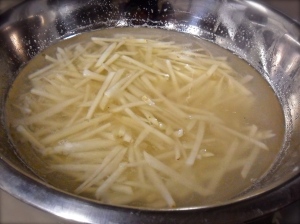
Seasonings, as always, are open to interpretation. They range from the most basic (salt) to my personal favorite: hot and sour, made possible with the use of Sichuan peppercorns, Sichuan chili peppers, and a lot of Chinese black vinegar (best approximated with sherry vinegar or a very un-sweet balsamic).
The key is to keep tasting for texture and flavor: you want the potatoes to be crunchy, but obviously not raw. They won’t be crispy like french fries, but should have the same satisfying contrast between crunchy exterior and soft inside.
I encourage you to munch these and tell me what you think. I’m sure Michael Pollan and others would agree that the potato is a vegetable, not a starch: After all, it does have leaves.

Stir-fried Potato Strings, Sichuan Style
(Serves 4-5)
Ingredients:
- 1/2 lb Russett potatoes, peeled and sliced into very thin matchsticks
- Water for soaking
- 2 TBSP peanut oil
- 1-2 TBSP Sichuan peppercorns
- 5-6 Sichuan chili peppers
- Salt and pepper
- 1/4 cup Chinese Black Vinegar
- Thinly sliced bell pepper or hot pepper, optional
- Sesame oil, optional
- Cilantro, for garnish, optional
Instructions:
- Put the sliced potatoes in a large boil and cover with cold water. Let sit for at least half an hour, changing the water once you see potato starch rising to the top.
- Rinse and drain. Blot with a paper towel or cloth.
- Heat the oil in a wok (MUST be a wok) on the highest heat possible, until it smokes.
- Toss in the peppercorns, taking care not to burn yourself (the oil might splatter). Toss with the oil just until they smell fragrant, then IMMEDIATELY transfer to another plate with a slotted spoon. They burn VERY quickly.
- (You can either discard the peppercorns or add them back to the wok later when the heat isn’t as high)
- Next, do the same thing with the chili peppers: fry in the same oil until fragrant but not burnt, then move to a plate.
- Keep the heat on high, then add the potatoes. Stir-fry for five minutes, adding water if they begin to stick. Season with salt and pepper.
- Add sliced pepper (optional) and keep stir-frying on high.
- Add vinegar and keep stir-frying.
- When potatoes are done to your liking, feel free to add the peppercorns and chilis back to the wok and heat everything through. (I even added additional chili peppers because I’m hardcore like that)
- Season with additional salt and vinegar to taste.
- Garnish with cilantro and a drizzle of sesame oil. Serve.
(Recipes in photo coming up, not to worry)

Happy Wednesday (aka Dining Section day) to you all. Ever since the Minimalist disappeared from the Dining Section’s pages, I’ve been forced to dedicate more attention to columns I otherwise would have skimmed over.
Case in point: The Pour, by Eric Asimov. I have neither the legal requirements nor the cash to spend money on booze, let alone classy wine. I can tell the difference between something like Yellowtail and a Cote-de-Rhone, obviously, but my wine-tasting palette… let’s just say it doesn’t hold a candle to my coffee snobbery.

Today’s article, Summing Up Wine in Two Words, may have been about wine, but for once, I could apply it to what I know: COFFEE. Both the coffee and wine industries are similar in that they tend to utilize overly pretentious vocabulary, with descriptions that I see as a game of word association (see my thoughts on this here).
Asimov seems to agree with this, saying,
Most of the gaudy descriptions found in tasting notes will not help a whit to understand the character of a bottle of wine or to anticipate the experience of drinking it. While it may seem heretical to say, the more specific the description of a wine, the less useful information is actually transmitted.
He goes on to add that each bottle will be different, depending on the time it’s opened and how much time passes before tasting (Just like coffee… see a pattern?). Asimov’s main point is that wines can be divided into two general types: sweet and savory. Now, I don’t especially think this holds true for coffee, but what really struck me was his definition of sweetness:
But when I use the word sweet, I’m thinking not only of actual sugar in the wine, but more often of the impression of sweetness… Savory wines, as you imagine, are the ones that don’t leave the impression of sweetness.
Now, just as I was reading these words, I happened to be sipping on some really excellent Intelligentsia Cruz Del Sur, Peru, which I’ve been drinking for the past week. The description on the bag says, “Balanced with a gentle acidity, easy-going notes of nougat, toasted dates provide depth. The finish is honeyed and chocolatey.”
I actually think this description is well-worded. Don’t know how much I taste nougat per se, but what I want to emphasize is the word “finish.” Note that the coffee itself is slightly acidic, but the aftertaste is rounder and sweeter. Before reading The Pour today, in my mind this coffee was just “sweet.” In fact, the description on Intelligentsia’s website claims that it “tastes like a big, chewy brownie.”
I profoundly disagree with this. Most brownies are stodgy, cloying and much too sweet. There isn’t much depth, and certainly no acidity. I’ve realized that going by the terms “sweet” and “savory,” Sumatras tend to be savory (associated with bell pepper flavors) for the same reason that South Americans tend to be sweet: their aftertaste.
So, take away two things from this post:
- If you are a wine snob, you have the potential to be a coffee snob, and vice versa (presuming you have the $$)
- Never chug coffee. Otherwise you’ll only taste the predominant flavors of the cup, and that elusive, subtle aftertaste that is, in effect, its “soul,” will vanish.
Ari’s Greek Eggplant
In case you missed it, last Monday was a veritable “United Nations” of meals, complete with Curry Cauliflower and Chickpeas and Greek Eggplant.
Eggplant = love. Bad eggplant is something no one should have to suffer through, but once you’ve had a truly good eggplant dish– where the flesh is meltingly tender, never oily– only then have you experienced one of life’s primal pleasures.

Previous eggplant recipes:
Authentic or not, Ari threw together a really fantastically filling Mediterranean eggplant dish, which she said was based on something she’d eaten at a Greek restaurant. Eggplant halves are smeared with a garlic-olive oil mixture, baked, then topped with a cumin-laced tomato sauce and feta cheese, if you so desire.
Broiling the eggplant at the last minute makes the top golden and slightly crispy, which, when cut with a knife, reveals the unctuous interior just below. Heady with the scent of olive oil and piquant cumin, it feels as satisfying as biting into a steak.
Since Ari didn’t use a recipe, all proportions are approximate. My philosophy is always more garlic, cumin, and black pepper. AND CHILI PASTE.
Ingredients (Serves 2):
For the sauce:
- 1 TBSP olive oil
- 1 onion, chopped
- 2 -4 garlic cloves, chopped
- 1 TBSP tomato paste
- 1-2 bay leaves
- 1 tsp dried basil (or substitute fresh)
- 1/2-1 tsp cumin
- Salt and pepper
For the eggplant:
- 1 eggplant
- Juice of 2 lemons
- Olive oil
- Salt and pepper
- Additional sauteed onions, optional
- Feta cheese, optional
Instructions:
- Make the sauce by it with heating olive oil on medium high heat, then adding the onions and garlic. (optional: set side a small portion of sauteed onions to top the eggplant later.) Next, add tomato paste, salt, basil, pepper, bay leaves, and cumin. Bring to a boil and reduce. Set aside.
- Pre-heat the oven to 400.
- Cut the eggplant in half and lightly coat it with olive oil on top, lemon juice, and sprinkle on salt and pepper.
- Bake on a baking sheet for about 20-25 mins or until soft
- Take the eggplant out and mush up the inside with a fork and mix then put the tomato-stuffed eggplant back in the oven until sizzling and then garnish with extra sauteed onions and garlic and feta cheese, if you so desire.
How to Conquer Tofu
Since it seems like my instructive post on stir-frying vegetables was well-received, I thought I would do a post along a similar vein.
My good friend Tim commented, asking:
Hey Lida, I used your stir-frying tips tonight and it worked great! I’ve tried to cook with tofu in the past and been less than successful – any tips? I really don’t know where to start…
What a loaded question. In my opinion, asking how to “cook with tofu” is similar with “what do I do with eggs?” And that’s really no exaggeration– just as eggs can be firm (hard-boiled or preserved), custardy (steamed or poached), or softly scrambled (stir-fried), tofu can take on all these texures– even more so, since it absorb the flavor of whatever sauce it’s added to.
Types of tofu (hard to soft):
Your standard grocery store will carry firm tofu. Firm and extra-firm are better for dishes intending to stand in for meat, or at least have a more substantial consistency. This is the kind of tofu you’ll want to drain and press between two plates with a heavy object on top for at least half an hour. It also benefits from marinating for an hour and then broiling or grilling. My favorite recipes for extra firm tofu come from one of my favorite cookbooks: The Flexitarian Kitchen, which has dishes like lemon thyme grilled tofu and crispy tofu pressed with garlic and mint. Just don’t serve these at an Asian meal– it’ll confuse everyone.
Now, going a notch softer, we have medium firm tofu, which is the most versatile. I like to use it for stir-fries and one pot meals, where the tofu contrasts nicely with the texture of the vegetables and makes everything heartier. My favorite usage would probably be in a curry, like Gingerbread Curry or Yellow Curry, where it soaks up the creamy coconut milk. Most Thai restaurants will fry their tofu in advance; I like the crunchiness, but not the oil, so I lightly sear my tofu in peanut oil, turning with chopsticks so all the sides cook evenly. When the tofu is browned, set it aside and start the curry. Add it at the very end.
Soft tofu is not the same as silken, so don’t be fooled! The two are interchangeable, but the mouthfeel is entirely different. Both soft and silken can be cubed (after draining, very important) gently with a sharp knife so that they don’t crumble. Whatever you add soft tofu to, you have to slide it into the sauce gently, so make sure everything else is heated through first. You’re not really going to be able to stir-fry unless you want it to disintegrate.
Possible uses for soft tofu are miso soup and stir-fries like bok choy and shiitake mushrooms with glass noodles.
Silken tofu is wonderful for a cold appetizer, drizzled with soy sauce and sprinkled with bonito flakes. For a traditional Chinese “salad,” try Tofu with Thousand Year Old Egg. Another comfort food of mine is any kind of Korean tofu stew with kimchi, soy bean paste, and optional egg and seafood. If I had any Korean ingredients on hand, that would definitely be on this week’s agenda.
The softest of the softest is Chinese tofu “brains,” or dou fu nao, which you can only really get on on the street or in a restaurant. The vendor scoops the freshest, lightest, creamiest curds out of a massive vat of fresh tofu. It’s not cubed– just eaten in a savory soy sauce-based gravy with chili oil and pickled vegetables on the side. In Shanghai, where the cuisine tends towards the blander and sweeter, it’s served simply with dried shrimp and scallions.
Finally, vegan substitutions. I really try to gravitate away from this kind of thing– not because I’m anti-veganism, but because I’m Asian– but if you must, you can make “scrambled tofu,” puree silken tofu to make salad dressings, smoothies, etc. I did, on one occasion, have a surprisingly delicious vegan chocolate pudding pie that I assume was made in a similar fashion.
The soy bean is a remarkable thing: soy milk, tofu, tempeh, tofu skin (yuba), spicy fermented dou fu ru, tofu “noodles…” This only hit the tip of the iceberg, the first of many soy posts to come.
Too often, tofu is thought of as a meat alternative– but it is so much more than that. In China, most tofu dishes are not even vegetarian (ma po dou fu usually has pork, and silken tofu is divine with whole fish). Tofu is valued for its light texture: we call it nen in Chinese, but there really is no English equivalent.
Under no circumstances would I ever force anyone to choose between cheese and tofu, two of the wonders of the world, but I think you know what I would pick. Rice and tofu or bread and cheese?
If only cows gave soy milk…
Tofu Recipes
- Tofu with Thousand Year Old Egg
- Gingerbread Curry
- Yellow Curry
- Chinese Whole Fish with Soft Tofu
- Bok Choy, Soft Tofu and Shiitake Mushrooms with Glass Noodles
- Mongolian Hot Pot
Curried Cauliflower and Chickpeas
How’s that for alliteration?
First, I want to apologize for this week. I can’t remember the last time I went so long without blogging. But I’m sure you understand that the life of a college student is hardly an idle one, and this week was on the stressful side.
I did, however, get the time to de-stress a little monday night and cook with my friend Ari IN A REAL KITCHEN.

The two of us are sharing Fruit and Veggie co-op, where we get a weekly shipment of produce. We managed to pull together an amazing vegetarian, quasi-ethnic meal that Ari called “the United Nations of meals” using all of our produce.
This is what we were given:
- Onions
- 1 Eggplant
- Lemons
- 1 Mango
- 1 Cauliflower
- A bag of apples
- 1 Head of lettuce
And this was our menu:
- Salad with Tabbouleh
- Mango Cardamom Lassi
- Curried Cauliflower and Chickpeas
- Greek Eggplant
- Cucumber Mint Raita
The eggplant was entirely Ari’s doing, and it was so wonderful that it merits its own post. For now, let’s focus on the cauliflower.
First of all, cauliflower happens to be one of the most underrated vegetables. Unfairly condemned as albino broccoli, unfortunate childhood memories of mushy, overcooked cauliflower diminishes its potential. Roast it with lots of olive oil and you have a filling side, crispy on the outside and creamy on the inside, almost reminiscent of french fries.
But where cauliflower shines the most, in my opinion, is in curry. I had a vision of a wholesome vegan dish with excessive amounts of turmeric and cumin, tempered with the sweetness of cinnamon and kicked up with cayenne and chili paste on the side. Because my spice blend was Indian, I opted for chickpeas rather than tofu. I wanted something to give it richness: hence, coconut milk. But too often, soupy coconut curries leave us too full, and Ari and I weren’t having any rice to absorb the sauce.
Luckily, I happened to have the cutest miniature cans of coconut milk. Just one of these babies was enough to bind the cauliflower and chickpeas, but not so much that the coconut flavor was overwhelming. The coconut is there, to be sure, but never upstages the spices and herbs. A handful of cilantro and mint liven up the dish. Add a squeeze of lemon and feast.
Gone is cauliflower’s pale facade: it’s spiced up, golden and glamorous. Hardly albino broccoli.
Curried Cauliflower and Chickpeas (Serves 3-4)
*As always, spice measurements are approximate. I happen to think in this case more is less.
Ingredients:
- 2 large onions, diced
- 6 cloves of garlic, chopped (yes, I said 6!)
- 2 TBSP olive oil/ other oil: I’m sure ghee would be delicious)
- 1 head of cauliflower, broken into florets
- 1 TBSP turmeric
- 2 tsp powdered ginger (If you have fresh ginger, that’s even better– add at least a 1-inch pice of it, sliced)
- At least 1 tsp cumin
- 1/2 tsp cayenne
- 1/2 tsp paprika
- 1 tsp Cinnamon
- Salt and pepper
- 1-2 TBSP curry spice blend such as garam masala
- Water as needed
- 1/2 large can of coconut milk, or one small can
- 2 cups cooked chickpeas
- 1/2 cup chopped cilantro
- 1/4 cup chopped mint
- Juice of one lemon
Instructions:
- Parboil the cauliflower. Do this by bringing a large pot of water to a boil, dropping the cauliflower in, bringing back to a boil, and waiting until the cauliflower are the vegetable equivalent of al dente. DO NOT OVERCOOK. Immediately drain and rinse with cold water.
- While the cauliflower is boiling, heat oil on medium high heat. When it sizzles, add the onions. Let onions saute until translucent, then add the garlic. Saute a minute or two more and add seasonings.
- Continue to cook the onions on low until they’re very soft. Add the cauliflower, coating it with the spice mixture and adding more of whatever you need to taste.
- Next, add the coconut milk and bring back to a boil. Let it all cook through.
- Finally, add the chickpeas at the last minute so you don’t overcook them. Heat everything, turn the heat back down and add the cilantro, mint, and lemon juice.
- Add salt, pepper and seasonings to taste (you’re probably going to want a lot more than you initially added).
- Serve with additional lemon and chili paste on the side.
Chemex Creations
I feel like I should be paying Alex for the amount I’ve learned about coffee this year– It’s like I’m enrolled in one of those $100 dollar barista courses, except I don’t have to pay anything (not to mention, I get to chill with some pretty awesome people in the process).
Neo, Alex and I convened in Espwesso (our student-run cafe, which I really don’t know why I haven’t written a post on yet) to brew the peaberry beans I bought at O Cafe. Little did I know that Alex, who had spent the weekend in New York, had brought a load of what he called “new toys,” including a Chemex.


The Chemex was actually my first introduction to pourover coffee, and to be honest, I was never a huge fan. To be fair, this was when I drank almost exclusively espresso and couldn’t appreciate coffee as a tea-like beverage with occasional fruity notes. I also couldn’t appreciate coffee that wasn’t scorching hot, and Chemex coffee takes a while.
(I did, however, make Indonesian Kopi Luwak on a Chemex.)
My “home base” cafe, Istria, recently made the transition from Chemex to Hario V60. When I asked Alex about this, he explained that Chemex is better for home brewing, since it makes enough to serve about two people.
I do, however, like the Chemex’s “rustic” appearance. To me, it looks like the sort of thing you would carry around in the desert while riding camel-back.
We tried out two coffees: the peaberry from O Cafe and a Joe Sumatra. Alex tweaked the grind a couple times for each coffee: I had no idea how he knew what to change; I was happy enough when I agreed that the first cup was overextracted. I don’t question, I just listen and watch the masters at work.
When it comes to tasting, I’m also just learning about flavor profiling. It’s so hard to articulate the underlying flavors within a cup of coffee even when you know they’re there. But then when acknowledges the presence of “red pepper notes” or even “fig,” you want to slap your forehead and wonder why you hadn’t thought of that.
This is all relative, of course– I do think that a lot of the time coffee labels are pretentious games of word association. “Sweet” becomes “caramel,” and the next thing you know, your coffee tastes like “a warm slice of apple pie on an autumn day, the crisp leaves blowing in the wind.” Exaggeration, I know.
The sumatra was great, don’t get me wrong, but the red pepper flavor Alex pointed out did catch me a little off-guard. I’m realizing that you never know what to expect from Indonesian coffees: every single cup I’ve had is different.
O Cafe’s peaberry still holds a dear place in my heart: the beans (which are tiny) are sweet and chocolatey, full-bodied but not too darkly roasted.
A trip to New York may be happening this weekend… who knows what coffee adventures lie in store?
How to Stir-fry Any Vegetable
It feels weird to blog again after unplugging. I’m not going to lie– I’ve never felt better in my life. To not even know what time it was, to realize that cliched as it sounds, setting daily routines make every day the same– when in actuality, every minute of every day is different. I felt cleansed, wishing I wasn’t such a slave to technology.
And then I remembered how rewarding it is to blog, to take photos of food, to get feedback from readers, and to feel like somewhere out there, there’s a world of people I don’t know who are hopefully reading this. I’m not going to stop food blogging– it’s my passion– but I am going to take Saturdays off, and that’s that.

Moving on: HOW TO STIR-FRY ANY VEGETABLE. Well, let’s just say any green vegetable for the time-being. I feel the need to do a post on this because my stir-fried vegetables are hardly even recipes. It feels redundant to post them again and again, yet I don’t feel confident that people think of various vegetables as interchangeable.
(See recipes for garlic spinach, watercress, and asparagus)
For as long as I can remember, my dad, FOOG (Father of Octopus Gourmet, if you’re new to the blog), has been making wonderful stir-fried vegetables in what he calls a “pure” style: with no ingredients other than garlic or ginger, peanut oil, salt, and sometimes corn starch, the vegetables really shine through. When you go to Chinatown, similarly to if you went to a Farmer’s Market, you wouldn’t pick what vegetables you were buying in advance; you would base your meal on whatever looked the best.
In Chinatown, they have all the classics: bok choy, baby bok choy, spinach, watercress, broccoli, etc., but they also have all kinds of leafy green crucifers that are not easily translatable. But you know what? It doesn’t matter what they’re called, or even what they are, really: as long as you get the feel for them, they can all be used interchangeably.
There really isn’t any “rule” as to whether you use garlic or ginger (or even scallions), but this is my opinion: vegetables that remain “drier,” like string beans, are best made with lots of slightly burned garlic (sliced, not chopped), whereas dishes that use cornstarch, like bok choy and broccoli, sing with the addition of slivered ginger. Watercress and spinach can go either way, but FOOG usually uses garlic and leaves out the cornstarch, letting the leaves wilt in a broth that then gets poured over rice.
Instructions for any green vegetable:
- Obviously, your first step is to wash your vegetables, especially if they’re leafy. Dry them if you want, but you don’t have to be too thorough. If you’re using something firmer, like broccoli, you can save time by parboiling it first, then rinsing it under cold water.
- Have your garlic/ginger chopped and ready to go, plus some cornstarch whisked with cold water if you’re using it. Next, heat some peanut oil in a wok until it smokes. Add the garlic/ginger and stir-fry on high until crispy.
- Add the vegetables and a pinch of salt. You may or may not need to add water. Let them cook down, but keep it on high. This is stir-frying, after all.
- Add cornstarch to wok if necessary, making sure it doesn’t clump. Taste for saltiness, let it all cook down, and serve.
Embarassingly easy, right? While I’m a purist and in this case less tends to be more, this “recipe” is really a rough guideline for what could metamorphose into a one-wok meal.
Example: what could have been a simple bok choy dish with ginger turned into an enormous medley of tofu, shiitake mushrooms and glass noodles.
Possible Additions:
- Oyster sauce
- Sesame oil
- Glass noodles
- Vinegar
- Dried shrimp
- Dried mushrooms
You get the idea. Stir-frying is meant to be easy. Why do you think I make so much of this in my dorm room? It’s simple, it’s quick, it’s real Chinese cooking– forget those everything-but-the-sink stir-fries that involve water chestnuts and baby corn (blasphemy!). A Chinese meal is meant to have multiple dishes– the whole point is to serve these dishes with something that contrasts well. So pull out the wok, cover up the smoke detector… and if all else fails, you can smother it all with chili paste.
Suggested pairings:
Unplugged: 5 UNdocumented Meals

Announcement: this blog is going to be SILENT from 6 PM tonight to 6 PM tomorrow.
Tonight, I’m unplugging. Yes, this program is Shabbat-oriented, but you really don’t have to be Jewish to do it. We all know technology controls us (always a comforting thought). And as much as I love the joys of blogging, there are definitely times where I just. Don’t. Want. To. Do. It. (But I do– this is how much I love you guys)
So in the spirit of the National Day of Unplugging, I’d like to share some meals and dishes that never made it on to this blog. Why? Because I never took a photo. I never wrote anything down. Their only documentation is in my head. I actually wrote an essay on this once, but it is nearly impossible to document taste– what you think of as remembering taste is really smell, touch, your surroundings… In order to remember what something tastes like, you really have to put it in context. Where was it eaten, and how did you feel eating it? Who were you with? How did you feel before you took the first bite/sip, and after you were finally satiated?
Writing and photography are currently the only way we can preserve food in our memories, and yet it remains maddeningly frustrating that we will never succeed. Blogging is my way of bringing food to you, but it really doesn’t change the way I feel about it. I can envision the dishes I’m about to mention just as well as what I ate this week, practically taste them on my tongue– but not quite.
Taste is elusive. It defies technology, even if we don’t.
Octopus Gourmet’s Top 5 UNdocumented Meals:
(Surprisingly, none of these are in China, which is what would first come to mind)
1. Strawberry milkshake in Costa Rica when I was nine. I was, believe it or not, the pickiest eater in the world, subsisting mainly on a diet of McDonalds and dumpling wrappers (I discarded the filling). The detour our mini tour bus made is still vivid in my memory. We had stopped at a tiny local shack, hardly even a restaurant, where without requesting anything, we were presented with glasses filled with a concoction of the palest pink. It was a milkshake, but not in the traditional sense. There was no ice cream– only the freshest, sweetest strawberries you will ever had, whirred quickly in the blender with creamy whole milk.
2. Vegetarian tagine in Montmartre in 2008. I did, in fact, return to the same restaurant and order the same dish, but good as it tasted, the magic had dissipated. My friend and I were lost and hungry. What looked deceptively small from the outside turned out to be the most comforting little Moroccan restaurant. First, there was mint tea, poured from a copper teapot with a long spout like a watering can. We sipped the steaming liquid in little shot glasses guilded with flower designs. The tea was almost too sweet, but the mint was cold, sending chills down my esophagus while the heat of the drink burned my chest. The tagines were next—served in clay pots, there were carrots, olives, zucchini, and preserved lemons. We ate in silence, letting our taste buds govern our minds, and occasionally we would find a dried apricot or fig, like buried treasure. The couscous had none of the metallic taste of the boxed kinds—the grains were fluffy, almost dissolving on our tongues. The meal, like the couscous, was too elusive. The ghost of the flavor lingered in my mouth, then disappeared as quickly as it had come.
3. Local stir-fried noodles in Shanxi province. I don’t particularly like noodles, but Shanxi is known for them. After a long morning of archaeological exploration, my parents and I stopped at a small courtyard house. There was elderly man, maybe in his sixties, who let us sit down. I don’t even remember if he was a complete stranger or not. What I do remember is the air, which was heady with the smell of ginger crisping in hot peanut oil. “Are you hungry?” He asked us. We were. A woman was turning out plates of chewy wheat noodles interwoven with tender napa cabbage. I slurped and chewed those noodles like I hadn’t eaten in days.
4. Butternut Squash and Apple soup with Pheasant at Blackbird in Chicago. I had finally overcome my phobias and become a die-hard foodie. I was also going through my fancy restaurant phase. That being said, I ordered this soup on three different occasions, it was that good. Squash and apple puree, without the unnecessary addition of cream, was sweet and velvety, but aggressively studded with house-made croutons and shreds of earthy pheasant.
5. Finally, salmon sashimi at Ajihei in Princeton, of all places. I was going from New York to Princeton with my cousin, and we had been given generous cab fare from our grandma. We didn’t end up taking a cab, so that money got added to the sushi fund. The restaurant is one of those places that is literally never open and located below street level. Everything we ordered was incredible– spider and salmon skin rolls were little bundles of crisp nirvana and silky avocado– but it was at Ajihei that I had the best salmon sashimi of my life. It was so marbled with fat as to be nearly stripey, so creamy chewing was unnecessary.
I realize that most people skim over wordy posts, which is why I do my best to avoid them. But I think we underestimate the power of words, which in many ways allow us to experience taste far better than a camera would.






















